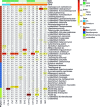Gypsum Cave Biofilm Communities are Strongly Influenced by Bat- And Arthropod-Related Fungi
- PMID: 38829422
- PMCID: PMC11147836
- DOI: 10.1007/s00248-024-02395-y
Gypsum Cave Biofilm Communities are Strongly Influenced by Bat- And Arthropod-Related Fungi
Abstract
The Gypsum Karst of Sorbas, Almeria, southeast Spain, includes a few caves whose entrances are open and allow the entry and roosting of numerous bats. Caves are characterized by their diversity of gypsum speleothems, such as stalactites, coralloids, gypsum crusts, etc. Colored biofilms can be observed on the walls of most caves, among which the Covadura and C3 caves were studied. The objective was to determine the influence that bat mycobiomes may have on the fungal communities of biofilms. The results indicate that the fungi retrieved from white and yellow biofilms in Covadura Cave (Ascomycota, Mortierellomycota, Basidiomycota) showed a wide diversity, depending on their location, and were highly influenced by the bat population, the guano and the arthropods that thrive in the guano, while C3 Cave was more strongly influenced by soil- and arthropod-related fungi (Ascomycota, Mortierellomycota), due to the absence of roosting bats.
Keywords: Ascomycota; Basidiomycota; Cladosporium; Fungi; Lecanicillium; Mortierella; Mortierellomycota; Podila; Arthropods; Bats; Gypsum Outcrops; Microbial Mats.
© 2024. The Author(s).
Conflict of interest statement
The authors declare that they have no known competing financial interests or personal relationships that could have appeared to influence the work reported in this paper.
Figures







Similar articles
-
Bacterial communities forming yellow biofilms in different cave types share a common core.Sci Total Environ. 2024 Dec 15;956:177263. doi: 10.1016/j.scitotenv.2024.177263. Epub 2024 Nov 8. Sci Total Environ. 2024. PMID: 39481555
-
Living in the dark: Bat caves as hotspots of fungal diversity.PLoS One. 2020 Dec 4;15(12):e0243494. doi: 10.1371/journal.pone.0243494. eCollection 2020. PLoS One. 2020. PMID: 33275627 Free PMC article.
-
DIVERSITY OF THE TYPE 1 INTRON-ITS REGION OF THE 18S rRNA GENE IN PSEUDOGYMNOASCUS SPECIES FROM THE RED HILLS OF KANSAS.J Zoo Wildl Med. 2016 Sep;47(3):883-885. doi: 10.1638/2015-0089.1. J Zoo Wildl Med. 2016. PMID: 27691955
-
Soil Microfungi of the Colombian Natural Regions.Int J Environ Res Public Health. 2020 Nov 10;17(22):8311. doi: 10.3390/ijerph17228311. Int J Environ Res Public Health. 2020. PMID: 33182736 Free PMC article. Review.
-
Effective conservation of subterranean-roosting bats.Conserv Biol. 2024 Feb;38(1):e14157. doi: 10.1111/cobi.14157. Epub 2023 Jul 28. Conserv Biol. 2024. PMID: 37504891 Review.
Cited by
-
Molluscicidal Screening of Hypocreales Fungi from a Brazilian Cerrado Cave Against Biomphalaria glabrata Snails.J Fungi (Basel). 2025 Feb 21;11(3):173. doi: 10.3390/jof11030173. J Fungi (Basel). 2025. PMID: 40137211 Free PMC article.
References
-
- Northup DE, Lavoie KH. Microbial diversity and ecology of lava caves. In: Engel AS, editor. Microbial Life of Cave Systems. Berlin: DeGruiter; 2015. pp. 161–192.
-
- Riquelme C, Hathaway JJM, Dapkevicius MLNE, Miller AZ, Kooser A, Northup DE, Jurado V, Fernandez O, Saiz-Jimenez C, Cheeptham N. Actinobacterial diversity in volcanic caves and associated geomicrobiological interactions. Front Microbiol. 2015;6:1342. doi: 10.3389/fmicb.2015.01342. - DOI - PMC - PubMed
-
- Martin-Pozas T, Fernandez-Cortes A, Cuezva S, Cañaveras JC, Benavente D, Duarte E, Saiz-Jimenez C, Sanchez-Moral S. New insights into the structure, microbial diversity and ecology of yellow biofilms in a Paleolithic rock art cave (Pindal Cave, Asturias, Spain) Sci Total Environ. 2023;897:165218. doi: 10.1016/j.scitotenv.2023.165218. - DOI - PubMed
MeSH terms
Substances
LinkOut - more resources
Full Text Sources
Medical
Miscellaneous

